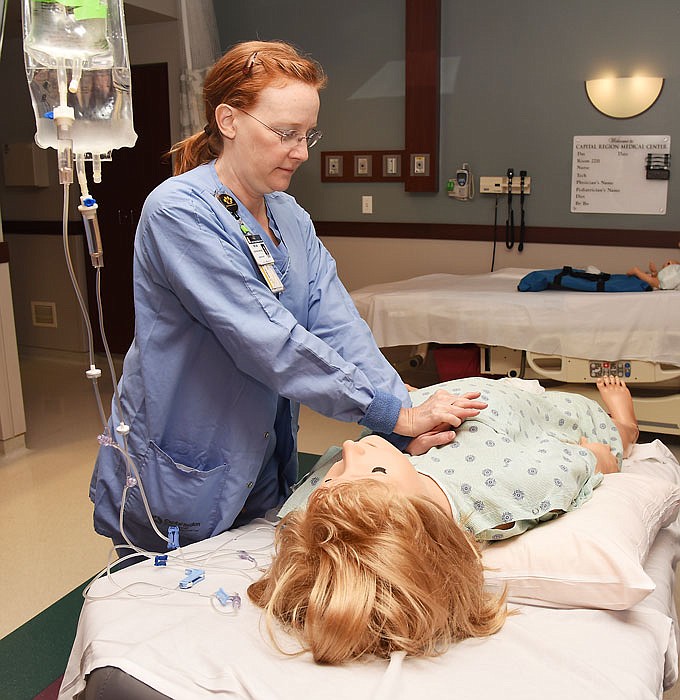Obstetric nurses at Capital Region Medical Center in Jefferson City have a new training tool at their disposal, and they call her Noelle.
A maternal and neonatal birthing simulator, Noelle - given the name by manufacturer Global Technologies - looks like a life-size pregnant Barbie but without the painted makeup. She's about 5-feet, 5-inches tall with short, shiny blonde hair, and she came with a $4,000 price tag. Since receiving Noelle in September, Cathy Lewis, registered nurse and obstetrics (OB) manager said Noelle has been invaluable.
Noelle's purpose is to birth an infant, which came with the package, and evoke emergency scenarios for the 28 nurses in the unit, who are responsible for assisting mothers in bringing new life to the world. Attached to a computer, she can be programmed for various scenarios. The challenges the OB nurses can face - both for mother and child - makes Noelle even more valuable to the team, said Lewis.
"We're responsible for lives - we have to be prepared," she said.
Nurses can check vitals on Noelle and hear a simulated heart beat, which can go faster or slower depending on the clinical simulation training. They can perform typical tasks like putting in an IV and checking the dilation of Noelle's cervix, a measurement nurses and doctors use to know when a mother is ready to deliver the baby.
This past fall, the OB unit - involving not only nurses, but also physicians, anesthesia and technical staff - trained for a situation that not is often seen but potentially dangerous for mothers. They performed a hemorrhage drill.
Noelle was programmed to birth the infant mannequin and then lose fake blood. Nurses were given signals before blood loss to suggest the problem could occur, such as paleness, lower back pain and dropping blood pressure, said Lori Green, a registered nurse and educator with Capital Region. They weighed the fake blood to estimate blood loss.
The sooner the medical emergency is identified, the better, Lewis said, and Noelle is helping make her nurses sharper.
"If we identify a problem early, the less impact on the patient," she said. "We can hopefully do some things before a patient gets into a lot of trouble."
The training recently paid off, said Crystal Schollmeyer, an OB charge nurse, as responses to hemorrhages and other codes (emergency situations) are becoming quicker.
"We've been able to give blood within 30 minutes in the room because we can recognize the problem, and just practicing with Noelle, we know the amount of blood (lost) and running through the steps," she said.
Training in a low-volume, high-risk situation is one of the best, most common uses for simulation mannequins, said Alison Williams, Missouri Hospital Association vice president of clinical quality improvement. Use of simulation mannequins have particularly been picking up in birthing hospitals, she added.
"The greatest benefit is being able to fail on a non-human," Williams said. "We don't ever want to fail with a real person, but these mannequins, because of their technology and ability to simulate and change things up to create a real-life environment, give (hospital staff) a chance to train - not only on technical skills but also on communication - as a team. They can also identify gaps where they can become more proficient and provide the best care, so that when a real patient presents problems, they are ready to go and there aren't a lot of delays in care."
The use of mannequins have been popular in medical training since the 1800s, said Jalene Bowersmith, executive director of the International Nursing Association for Clinical Simulation and Learning.
In the last 20 years, technology has been able to develop mannequins that contain bodily fluids and speak. Simulation training took off in the 1990s, and over the past few years, she said, it has become increasingly popular.
Student nurses can go through weeks worth of clinicals and never experience certain emergencies. That's when simulation mannequins, like Noelle, become important, Bowersmith said.
"There are so many accidents that can occur, it's important to give students a safe environment to learn," she said.
This year, the Capital Region OB unit will utilize Noelle to train on preeclampsia, a pregnancy complication due to high blood pressure.
"Noelle just sets us at an advantage to prepare our staff to deal with the normal - like how to check a cervix - and the things that don't happen everyday," Lewis said. "It's a multi-pronged approach - how do we train nurses to do the normal, everyday things at that (high) level but also prepare for those emergencies that don't happen everyday."

